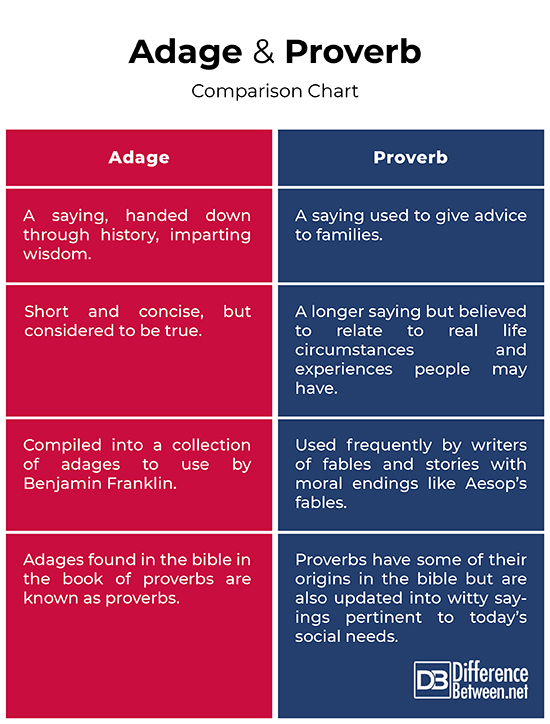Difference Between Adage and Proverb
Proverbs and adages are short sayings that people remember because of the advice they may give, or the truths they may tell. Generally proverbs and adages relate to every day life experiences. They are wise and often used by parents and grandparents to teach children simple, but poignant life lessons. Adages have been in circulation longer than proverbs and proverbs tend to be more widely used, but both types of sayings are meaningful. A proverb is often part of a story or a fable with a moral. There is not a great deal of difference between the usage of the two in literary circles. A proverb and an adage are synonymous with one another. Generally speaking a proverb gives a piece of advice while an adage suggests a truth about how everyday events can affect the reader’s life.
What is an Adage?
Adages have been in use for longer than proverbs. They are sayings that have deeper meaning than the words read at face value. Adages are considered by many people to be true sayings. People have come to trust the truth in an adage because they have been in existence for a long time and have been handed down through the ages. The word adage comes from the Latin word adagium meaning ‘saying.’ It is interesting to note that any adage taken from the biblical book of Proverbs is known as a proverb and not an adage.
Some typical well known adages are:
Love is blind.
Better safe than sorry.
Nothing ventured nothing gained.
What is a Proverb?
A proverb is very similar to an adage. However, proverbs tend to be longer. They reflect common sense advice and are perceived as truths. Proverbs are thought to have originated from real experiences. The word proverb comes from the Latin proverbium its literally meaning is train. That is what proverbs do as they are widely used to teach and train life lessons. Proverbs continue to evolve from their early creation by philosophers such as Confusious and plato to today’s proverbs or wise says that are in circulation. Many proverbs seem to be inspired by nature.
For example:
You can lead a horse to water but you can’t make it drink
An apple a day keeps the doctor away
A bird in the hand is worth two in the bush.
Proverbs have become part of different cultures and often reflect the morals and traditional beliefs of a culture. Modern proverbs are both witty and wise and give rise to debate on values as well as modern styles of living. It has been said that a proverb is the ‘wit of one and the wisdom of many.’
Women and motorcycles are joys and griefs. A modern proverb showing both wit and wisdom to potential bikers!
It appears that over 1400 proverbs were added to the traditional ones during the 20th century.
What role do Adages and Proverbs Play in Society?: Adage Vs. Proverb
It is really quite difficult to have a clear dividing line between groups of proverbs and adages and their use in literary and social circles. They have been quoted, included in literature and drama, used to educate and amuse. Together they can fall under the same umbrella as a humorous tool to admonish and enlighten families and friends in the following ways:
- As advice:
Adages and proverbs are considered to be a true sayings and useful for giving advice. They come from a perceived third party and so are not found to be offensive. Adages are considered to be reliable truths because they have been handed down over time. Proverbs are often witty, but there is a truth behind the humor. An African adage that has become widely used tells us that ‘It takes a village to raise a child.’ Adages like this are relevant to many circumstances and the responsibility of raising a child.
- Historically:
Adages have formed part of different cultures and philosophies. They have stood the test of time in giving wise sayings, believed to be true. Benjamin Franklin wrote Poor Richard’s Almanac covering a collection of adages. Many of these sayings we are very familiar with. Many proverbs had their origin in the bible through the book of proverbs and the message Jesus shared with his followers at that time.
For example:
‘Early to bed early to rise makes a man healthy, wealthy and wise.’
‘Eat to live not live to eat.’
Many proverbs had their origin in the bible through the book of proverbs and the message Jesus and his followers shared at that time.
Pride comes before a fall. Proverbs 16:18
Love of money is the root of all evil 1 Timothy 6:10
Are both well known proverbs from the bible.
- In literature:
Aesop’s fables are classical treasures and enjoyed because of their use of proverbs and adages. The well loved tale of the Hare and the Tortoise is based on the words from the proverb ‘Slow and steady wins the race.’ Other less known fables describe proverbs like ‘familiarity breeds contempt, from the Fox and the Lion.
Alfred Lord Tennyson used ‘Better to be loved and lost than never to have loved in his works called Memoriam.
- Music and Drama:
Musicians, especially folk singers have used proverbs and adages in their lyrics. Bob Dylan uses part of a proverb in his song ‘Like a rolling stone.’ the proverb being – A Rolling stone gathers no moss. The well known movie Forest Gump introduces the proverb ‘Life is like a box of chocolates, you never know what you’re gonna get.’
- Advertising:
Proverbs and adages have been modified to become part of advertising campaigns. People associate with these sayings and see the connection in an advertising slogan. These adverts are considered clever with their play on words and use of well known sayings.
For example:
- Live by the sauce. Dine by the sauce. Used by Buffalo Wild Wings.
Adapted from the adage: Live by the sword and die by the sword
- If at first you don’t succeed… you are using the wrong equipment. Used by John Deere.
Adapted from the proverb: If at first you don’t succeed then try and try again.
Cartooning:
- Cartoonists have made use of proverbs and adages for their political satire or just a funny joke. The proverb or adage is used to build text around a topic or to bring humor to an otherwise irritating or disheartening situation.
‘Hear no evil, see no evil and speak no evil’ with the three wise monkeys has been one of the cartoonists favorite images.
- Culturally:
Many proverbs and adages reflect human experience and the morals and attitudes of different cultures. Some of these sayings or cultural proverbs are more familiar to specific cultural groups but their messages are relevant to all kinds of cultural groups.
- For example:
As a boy should resemble his father, so should the proverb fit the conversation (Ethiopia)
It is the nail that sticks out that gets hammered (Japan)
Both witty and wise these proverbs make readers think about their deeper meaning and remember the advice given in simple terms.
Adage and Proverb: Comparison Chart
Summary of Adage Vs. Proverb:
- There is no doubt that proverbs and adages are very similar.
- The main difference between these two literary devices seems to be in the age of the saying, adage being the one that comes with age. An adage is usually shorter than a proverb. Proverbs apply more frequently to modern society
- Proverbs and adages give added impact to a piece of writing. The written work could be a story, a fable, a song or even an advertisement.
- There are many uses for adages and proverbs in the commercial world. A clever advert using part of a proverb can attract the attention of the reader as they recognize the play on words through the proverb used in an advert.
- Graphic artists and cartoonists find proverbs and adages very useful in the creation of cartoons. The witty sayings add humor and a satirical element to a cartoon caption.
- Proverbs make an impact because they are examples of real life experiences turned into words of warning or wisdom. Adages are seen to be true because they have been handed down through generations and used frequently by parents and teachers.
- It would be safe to say that generally speaking it is difficult to tell the difference between an adage and a proverb and these two types of sayings are easily confused.
- Difference Between Lagoon and Bay - October 20, 2021
- Difference Between Futurism and Preterism - August 12, 2021
- Difference Between Dichotomy and Paradox - August 7, 2021
Search DifferenceBetween.net :
Leave a Response
References :
[0]Norquist Richard. February 15th 2018. the difference between Adage and Proverb. Www.thought.co.com. Pub. Dotdash Pub. Company.
[1]Image credit: https://live.staticflickr.com/8124/28936768504_599f5bf3c3_z.jpg
[2]Image credit: https://live.staticflickr.com/956/28351856838_fdf524fdb4_c.jpg



